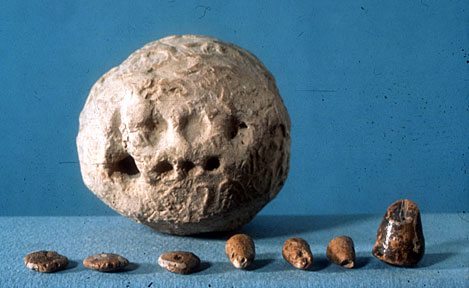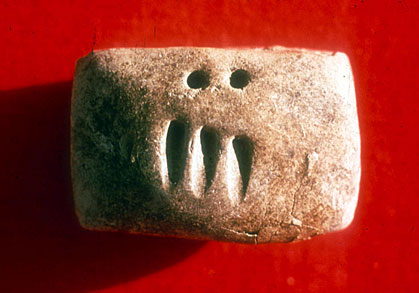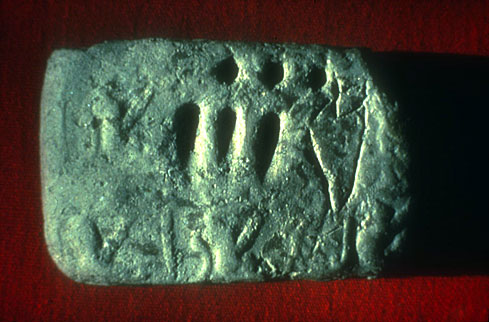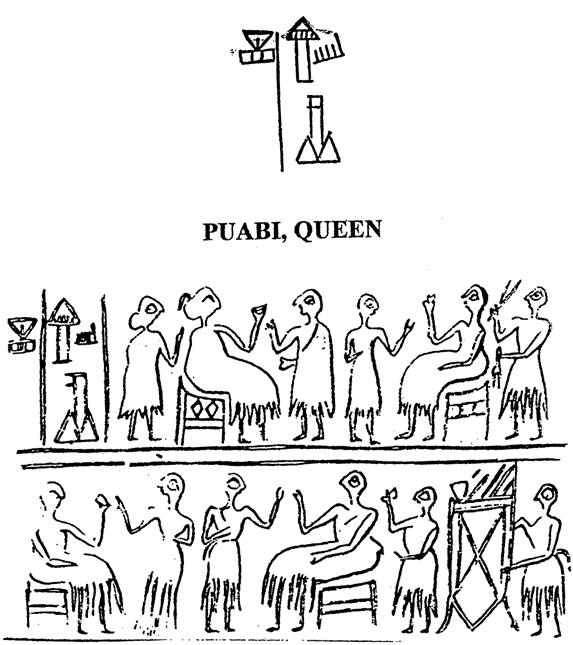The Sumerians Developed A System Of Writing Known As
![]() Download the PDF (1.4 MB)
Download the PDF (1.4 MB)
Published in James Wright, ed., INTERNATIONAL ENCYCLOPEDIA OF SOCIAL AND BEHAVIORAL SCIENCES, Elsevier, 2014
Abstract
Writing – a system of graphic marks representing the units of a specific language – has been invented independently in the Near East, China and Mesoamerica. The cuneiform script, created in Mesopotamia, present-day Iraq, ca. 3200 BC, was first. It is also the only writing system which can be traced to its earliest prehistoric origin. This antecedent of the cuneiform script was a system of counting and recording goods with clay tokens. The evolution of writing from tokens to pictography, syllabary and alphabet illustrates the development of information processing to deal with larger amounts of data in ever greater abstraction.
Introduction
The three writing systems that developed independently in the Near East, China and Mesoamerica, shared a remarkable stability. Each preserved over millennia features characteristic of their original prototypes. The Mesopotamian cuneiform script can be traced furthest back into prehistory to an eighth millennium BC counting system using clay tokens of multiple shapes. The development from tokens to script reveals that writing emerged from counting and accounting. Writing was used exclusively for accounting until the third millennium BC, when the Sumerian concern for the afterlife paved the way to literature by using writing for funerary inscriptions. The evolution from tokens to script also documents a steady progression in abstracting data, from one-to-one correspondence with three-dimensional tangible tokens, to two-dimensional pictures, the invention of abstract numbers and phonetic syllabic signs and finally, in the second millennium BC, the ultimate abstraction of sound and meaning with the representation of phonemes by the letters of the alphabet.
Writing is humankind's principal technology for collecting, manipulating, storing, retrieving, communicating and disseminating information. Writing may have been invented independently three times in different parts of the world: in the Near East, China and Mesoamerica. In what concerns this last script, it is still obscure how symbols and glyphs used by the Olmecs, whose culture flourished along the Gulf of Mexico ca 600 to 500 BC, reappeared in the classical Maya art and writing of 250-900 AD as well as in other Mesoamerican cultures (Marcus 1992). The earliest Chinese inscriptions, dated to the Shang Dynasty, c. 1400–1200 BC, consist of oracle texts engraved on animal bones and turtle shells (Bagley 2004). The highly abstract and standardized signs suggest prior developments, which are presently undocumented.
Of these three writing systems, therefore, only the earliest, the Mesopotamian cuneiform script, invented in Sumer, present-day Iraq, c. 3200 BC, can be traced without any discontinuity over a period of 10,000 years, from a prehistoric antecedent to the present-day alphabet. Its evolution is divided into four phases: (a) clay tokens representing units of goods were used for accounting (8000–3500 BC); (b) the three dimensional tokens were transformed into two-dimensional pictographic signs, and like the former tokens, the pictographic script served exclusively for accounting (3500–3000 BC); (c) phonetic signs, introduced to transcribe the name of individuals, marked the turning point when writing started emulating spoken language and, as a result, became applicable to all fields of human experience (3000–1500 BC); (d) with two dozen letters, each standing for a single sound of voice, the alphabet perfected the rendition of speech. After ideography, logography and syllabaries, the alphabet represents a further segmentation of meaning.
1. Tokens as Precursor of Writing
The direct antecedent of the Mesopotamian script was a recording device consisting of clay tokens of multiple shapes (Schmandt-Besserat 1996). The artifacts, mostly of geometric forms such as cones, spheres, disks, cylinders and ovoids, are recovered in archaeological sites dating 8000–3000 BC (Fig. 1). The tokens, used as counters to keep track of goods, were the earliest code—a system of signs for transmitting information. Each token shape was semantic, referring to a particular unit of merchandise. For example, a cone and a sphere stood respectively for a small and a large measure of grain, and ovoids represented jars of oil. The repertory of some three hundred types of counters made it feasible to manipulate and store information on multiple categories of goods (Schmandt-Besserat 1992).

Département des Antiquités Orientales)
The token system had little in common with spoken language except that, like a word, a token stood for one concept. Unlike speech, tokens were restricted to one type of information only, namely, real goods. Unlike spoken language, the token system made no use of syntax. That is to say, their meaning was independent of their placement order. Three cones and three ovoids, scattered in any way, were to be translated 'three baskets of grain, three jars of oil.' Furthermore, the fact that the same token shapes were used in a large area of the Near East, where many dialects would have been spoken, shows that the counters were not based on phonetics. Therefore, the goods they represented were expressed in multiple languages. The token system showed the number of units of merchandize in one-to-one correspondence, in other words, the number of tokens matched the number of units counted: x jars of oil were represented by x ovoids. Repeating 'jar of oil' x times in order to express plurality is unlike spoken language.
2. Pictography: Writing as Accounting Device
After four millennia, the token system led to writing. The transition from counters to script took place simultaneously in Sumer and Elam, present-day western Iran when, around 3500 BC, Elam was under Sumerian domination. It occurred when tokens, probably representing a debt, were stored in envelopes until payment. These envelopes made of clay in the shape of a hollow ball had the disadvantage of hiding the tokens held inside. Some accountants, therefore, impressed the tokens on the surface of the envelope before enclosing them inside, so that the shape and number of counters held inside could be verified at all times (Fig. 1). These markings were the first signs of writing. The metamorphosis from three-dimensional artifacts to two-dimensional markings did not affect the semantic principle of the system. The significance of the markings on the outside of the envelopes was identical to that of the tokens held inside.
About 3200 BC, once the system of impressed signs was understood, clay tablets—solid cushion-shaped clay artifacts bearing the impressions of tokens—replaced the envelopes filled with tokens. The impression of a cone and a sphere token, representing measures of grain, resulted respectively in a wedge and a circular marking which bore the same meaning as the tokens they signified (Fig. 2). They were ideograms—signs representing one concept. The impressed tablets continued to be used exclusively to record quantities of goods received or disbursed. They still expressed plurality in one-to-one correspondence.

Pictographs—signs representing tokens traced with a stylus rather than impressed—appeared about 3100 BC. These pictographs referring to goods mark an important step in the evolution of writing because they were never repeated in one-to-one correspondence to express numerosity. Besides them, numerals—signs representing plurality—indicated the quantity of units recorded. For example, '33 jars of oil' were shown by the incised pictographic sign 'jar of oil', preceded by three impressed circles and three wedges, the numerals standing respectively for '10' and '1' (Fig. 3). The symbols for numerals were not new. They were the impressions of cones and spheres formerly representing measures of grain, which then had acquired a second, abstract, numerical meaning. The invention of numerals meant a considerable economy of signs since 33 jars of oil could be written with 7 rather then 33 markings.

In sum, in its first phase, writing remained mostly a mere extension of the former token system. Although the tokens underwent formal transformations from three- to two-dimensional and from impressed markings to signs traced with a stylus, the symbolism remained fundamentally the same. Like the archaic counters, the tablets were used exclusively for accounting (Nissen and Heine 2009). This was also the case when a stylus, made of a reed with a triangular end, gave to the signs the wedge-shaped 'cuneiform' appearance (Fig. 4). In all these instances, the medium changed in form but not in content. The only major departure from the token system consisted in the creation of two distinct types of signs: incised pictographs and impressed numerals. This combination of signs initiated the semantic division between the item counted and number.

3. Logography: Shift from Visual to Aural
About 3000 BC, the creation of phonetic signs—signs representing the sounds of speech—marks the second phase in the evolution of Mesopotamian writing, when, finally, the medium parted from its token antecedent in order to emulate spoken language. As a result, writing shifted from a conceptual framework of real goods to the world of speech sounds. It shifted from the visual to the aural world.
With state formation, new regulations required that the names of the individuals who generated or received registered merchandise were entered on the tablets. The personal names were transcribed by the mean of logograms—signs representing a word in a particular tongue. Logograms were easily drawn pictures of words with a sound close to that desired (for example in English the name Neil could be written with a sign showing bent knees 'kneel'). Because Sumerian was mostly a monosyllabic language, the logograms had a syllabic value. A syllable is a unit of spoken language consisting of one or more vowel sounds, alone, or with one or more consonants. When a name required several phonetic units, they were assembled in a rebus fashion. A typical Sumerian name 'An Gives Life' combined a star, the logogram for An, god of heaven, and an arrow, because the words for 'arrow' and 'life' were homonyms. The verb was not transcribed, but inferred, which was easy because the name was common.
Phonetic signs allowed writing to break away from accounting. Inscriptions on stone seals or metal vessels deposited in tombs of the 'Royal Cemetery' of Ur, c. 2700–2600 BC, are among the first texts that did not deal with merchandise, did not include numerals and were entirely phonetic (Schmandt-Besserat 2007) The inscriptions consisted merely of a personal name: 'Meskalamdug,' or a name and a title: 'Puabi, Queen' (Fig. 5). Presumably, these funerary texts were meant to immortalize the name of the deceased, thereby, according to Sumerian creed, ensuring them of eternal life. Other funerary inscriptions further advanced the emancipation of writing. For example, statues depicting the features of an individual bore increasingly longer inscriptions. After the name and title of the deceased followed patronymics, the name of a temple or a god to whom the statue was dedicated, and in some cases, a plea for life after death, including a verb. These inscriptions introduced syntax, thus bringing writing yet one step closer to speech.

After 2600–2500 BC, the Sumerian script became a complex system of ideograms mixed more and more frequently with phonetic signs. The resulting syllabary—system of phonetic signs expressing syllables—further modeled writing on to spoken language (Rogers 2005). With a repertory of about 400 signs, the script could express any topic of human endeavor. Some of the earliest syllabic texts were royal inscriptions, and religious, magic and literary texts.
The second phase in the evolution of the Mesopotamian script, characterized by the creation of phonetic signs, not only resulted in the parting of writing from accounting, but also its spreading out of Sumer to neighboring regions. The first Egyptian inscriptions, dated to the late fourth millennium BC, belonged to royal tombs (Baines 2007). They consisted of ivory labels and ceremonial artifacts such as maces and palettes bearing personal names, written phonetically as a rebus, visibly imitating Sumer. For example, the Palette of Narmer bears hieroglyphs identifying the name and title of the Pharaoh, his attendants and the smitten enemies. Phonetic signs to transcribe personal names, therefore, created an avenue for writing to spread outside of Mesopotamia. This explains why the Egyptian script was instantaneously phonetic. It also explains why the Egyptians never borrowed Sumerian signs. Their repertory consisted of hieroglyphs representing items familiar in the Egyptian culture that evoked sounds in their own tongue.
The phonetic transcription of personal names also played an important role in the dissemination of writing to the Indus Valley where, during a period of increased contact with Mesopotamia, c. 2500 BC, writing appears on seals featuring individuals' names and titles (Parpola 1994). In turn, the Sumerian cuneiform syllabic script was adopted by many Near Eastern cultures who adapted it to their different linguistic families and in particular, Semitic (Akkadians and Eblaites); Indo-European (Mitanni, Hittites, and Persians); Caucasian (Hurrians and Urartians); and finally, Elamite and Kassite. It is likely that Linear A and B, the phonetic scripts of Crete and mainland Greece, c. 1400–1200 BC, were also influenced by the Near East.
4. The Alphabet: The Segmentation of Sounds
The invention of the alphabet about 1500 BC ushered in the third phase in the evolution of writing in the ancient Near East (Sass 2005). The first, so-called Proto-Sinaitic or Proto-Canaanite alphabet, which originated in the region of present-day Lebanon, took advantage of the fact that the sounds of any language are few. It consisted of a set of 22 letters, each standing for a single sound of voice, which, combined in countless ways, allowed for an unprecedented flexibility for transcribing speech (Powell 2009). This earliest alphabet was a complete departure from the previous syllabaries. First, the system was based on acrophony—signs to represent the first letter of the word they stood for—for example an ox head (alpu) was 'a,' a house (betu) was b (Fig. 6). Second, it was consonantal—it dealt only with speech sounds characterized by constriction or closure at one or more points in the breath channel, like b, d, l, m, n, p, etc. Third, it streamlined the system to 22 signs, instead of several hundred.

The transition from cuneiform writing to the alphabet in the ancient Near East took place over several centuries. In the seventh century BC the Assyrian kings still dictated their edicts to two scribes. The first wrote Akkadian in cuneiform on a clay tablet; the second Aramaic in a cursive alphabetic script traced on a papyrus scroll. The Phoenician merchants established on the coast of present day Syria and Lebanon, played an important role in the diffusion of the alphabet. In particular, they brought their consonantal alphabetic system to Greece, perhaps as early as, or even before 800 BC. The Greeks perfected the Semitic alphabet by adding letters for vowels—speech sounds in the articulation of which the breath channel is not blocked, like a, e, i, o, u. As a result the 27-letter Greek alphabet improved the transcription of the spoken word, since all sounds were indicated. For example, words sharing the same consonants like 'bad,' 'bed,' 'bid,' 'bud,' could be clearly distinguished. The alphabet did not subsequently undergo any fundamental change.
5. The Modern Alphabets
Because the alphabet was invented only once, all the many alphabets of the world, including Latin, Arabic, Hebrew, Amharic, Brahmani and Cyrillic, derive from Proto-Sinaitic. The Latin alphabet used in the western world is the direct descendant of the Etruscan alphabet (Bonfante 2002). The Etruscans, who occupied the present province of Tuscany in Italy, adopted the Greek alphabet, slightly modifying the shape of letters. In turn, the Etruscan alphabet became that of the Romans, when Rome conquered Etruria in the first century BC. The alphabet followed the Roman armies. All the nations that fell under the rule of the Roman Empire became literate in the first centuries of our era. This was the case for the Gauls, Angles, Saxons, Franks and Germans who inhabited present-day France, England and Germany.
Charlemagne (800 AD) had a profound influence on the development of the Latin script by establishing standards. In particular a clear and legible minuscule cursive script was devised, from which our modern day lower case derives. The printing press invented in 1450 dramatically multiplied the dissemination of texts, introducing a new regularity in lettering and layout. The Internet catapults the alphabet into cyberspace, while preserving its integrity
6. Writing: Handling Data in Abstraction
Beyond the formal and structural changes undergone by writing in the course of millennia, its evolution also involved strides in the ability to handle data in abstraction. At the first stage, the token system antecedent of writing, already abstracted information in several ways. First, it translated daily-life commodities into arbitrary, often geometric forms. Second, the counters abstracted the items counted from their context. For example, sheep could be accounted independently of their actual location. Third, the token system separated the data from the knower. That is to say, a group of tokens communicated directly specific information to anyone initiated in the system. This was a significant change for an oral society, where knowledge was transmitted by word of mouth from one individual to another, face to face. Otherwise, the token system represented plurality concretely, in one-to-one correspondence. Three jars of oil were shown by three tokens, as it is in reality. At the same time, the fact that the token system used specific counters to count different items was concrete—it did not abstract the notion of item counted from that of number. (Certain English numerical expressions referring to particular sets, such as twin, triplet, quadruplet and duo, trio or quartet, are comparable to concrete numbers.)
When tokens were impressed on the envelopes to indicate the counters enclosed inside, the resulting markings could no longer be manipulated by hand. In other words, the transmutation of three-dimensional counters into two-dimensional signs constituted a second step in abstraction. By doing away with tokens, the clay tablets marked a third level of abstraction since the impressed markings no longer replicated a set of actual counters. The invention of numerals, which separated the notion of numerosity from that of the item counted, was a crucial fourth step in abstraction. The signs expressing the concept of oneness, twoness, etc., allowed plurality to be dealt with in fully abstract terms. In turn, the phonetic units marked a fifth step of abstraction, since the signs no longer referred to the objects pictured, but rather the sound of the word they evoked.
Phonetics allowed writing to shift from a representational to a conceptual linguistic system. That is to say it enabled writing to leave the realm of real goods in order to enter the world of words and the ideas they stand for. Finally, the process that started with ideograms expressing concepts and phonetic signs referring to the sound of monosyllabic words reached the ultimate segmentation of meaning with letters. As Marshall McLuhan (1997) defined it, the alphabet consists of semantically meaningless letters corresponding to semantically meaningless sounds. The alphabet brought data handling to a final double-stepped abstraction.
7. Conclusion: The Stability of Writing Systems
The origin of the Chinese script and the development of Mesoamerican writing are still obscure. The Mesopotamian script, however, offers a well-documented evolution over a continuous period of 10,000 years. The system underwent drastic changes in form, gradually transcribed spoken language more accurately, and handled data in more abstract terms. The most striking universal feature of all writing systems, however, is their uncanny endurance, unmatched among human creations. The Chinese script never needed to be deciphered because the signs have changed little during the 3400 years of its recorded existence (Xigui 2000). It also always remained ideographic, merely inserting rebus-like phonetic complements in some characters. The Mesoamerican Maya phonetic glyphs preserved the symbolism initiated by the Olmecs in the previous millennium (Coe and Van Stone 2005). Finally, when the last clay tablet was written in the Near East, c. 300 AD, the cuneiform script had been in use for three millennia. It replaced an age-old token system that had preceded it for over 5000 years; it was replaced by the alphabet, which we have now used for 3500 years.
References
Bagley, R. W. (2004). Anyang writing and the Origin of the Chinese writing system. In S.D.
Houston (Ed.). The First Writing (pp. 190-249). Cambridge: Cambridge University Press.
Baines, J. (2007). Visual and Written culture in Ancient Egypt. Oxford: Oxford University Press, Cambridge: Cambridge University Press.
Black, J. (2008) The Obsolescence and Demise of the Cuneiform Writing in Elam. In J. Baines, J. Bennet, S. Houston (eds). The Disappearance of Writing Systems (pp.45-72). London: Equinox.
Bonfante, G., Bonfante, L. (2002) The Etruscan Language (revised edition). Manchester: Manchester University Press.
Coe, M. D. and van Stone, M. (2005) Reading the Maya Glyphs, Thames and Hudson, London.
Malafouris L, (2010) Grasping the concept of number: How did the sapient mind move beyond approximation, in: I. Morley & C. Renfrew (eds.), The Archaeology of Measurement. Cambridge: Cambridge University Press. (pp.35-42)
Marcus, J. (1992). Mesoamerican Writing Systems. Princeton: Princeton University Press.
Moos, M. A. ed., (1997) Marshall McLuhan Essays, Media Research. Amsterdam:Overseas Publishers Association.
Nissen, H. J., & Heine, P. (2009). From Mesopotamia to Iraq. Chicago, IL: University of Chicago Press.
Parpola, A. (1994) Deciphering the Indus Script. Cambridge: Cambridge University Press.
Powell, B. B. (2009). Writing: Theory and History of the Technology of Civilization. London: Wiley Blackwell.
Rogers, H. (2005). Writing Systems, A Linguistic Approach. London: Blackwell.
Salomon, R. (2012). Some Principles and Patterns of Script Change. In S.D. Houston (ed). The Shape of Script. (pp. 119-133) Santa Fe: Sar Press.
Sass, B. (2005) The Alphabet at the Turn of the Millennium, The West Semitic Alphabet ca. 1150-850 BC – The Antiquity of the Arabian, Greek and Phrygian Alphabets, Tel Aviv: Tel Aviv University.
Schmandt-Besserat, D. (2007) When Writing Met Art. Austin, Texas: University of Texas Press.
Schmandt-Besserat, D. (1996). How Writing Came About. Austin, Texas: University of Texas Press.
Schmandt-Besserat, D. (1992). Before Writing. (2 vols). Austin, Texas: University of Texas Press.
Xigui, Q. (2000) Chinese Writing, The Institute of East Asian Studies, The University of California, Berkeley.
Glossary
Abstraction: Consider the property of an item dissociated from any specific instance.
Abstract counting: When numbers are considered separately from the items counted.
Alphabet: A writing system based on a set of letters, each standing for a single spoken sound.
Concrete counting: the use of different sets of numbers to count different set of items.
Cuneiform: The writing system developed in Mesopotamia in the fourth millennium BC. The script was written with a triangular stylus, which gave the stroke their characteristic angular shape.
Logography: a sign refers to one word.
Numeral: a sign to write a number.
Pictograph: A character in the form of a picture representing either the sound of the word it evokes or the object represented.
Syllabary: A writing system based on characters each representing a syllable, or unit of spoken language consisting of at least a vowel with, sometimes, additional vowels or consonants.
Tablet a lump of clay prepared in a cushion shape to support a written document.
Writing : A system of human communication by the mean of arbitrary visual signs.
Page last updated: 2/6/21
The Sumerians Developed A System Of Writing Known As
Source: https://sites.utexas.edu/dsb/tokens/the-evolution-of-writing/
Posted by: robinsonmuld1978.blogspot.com

0 Response to "The Sumerians Developed A System Of Writing Known As"
Post a Comment